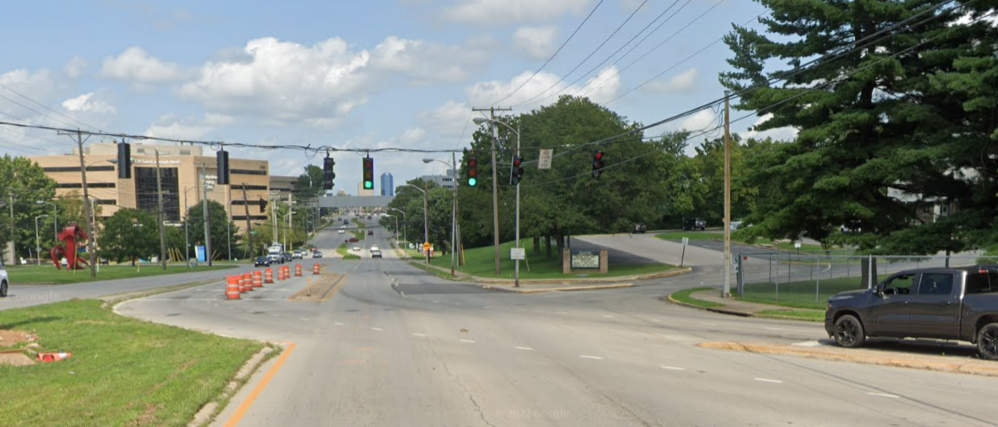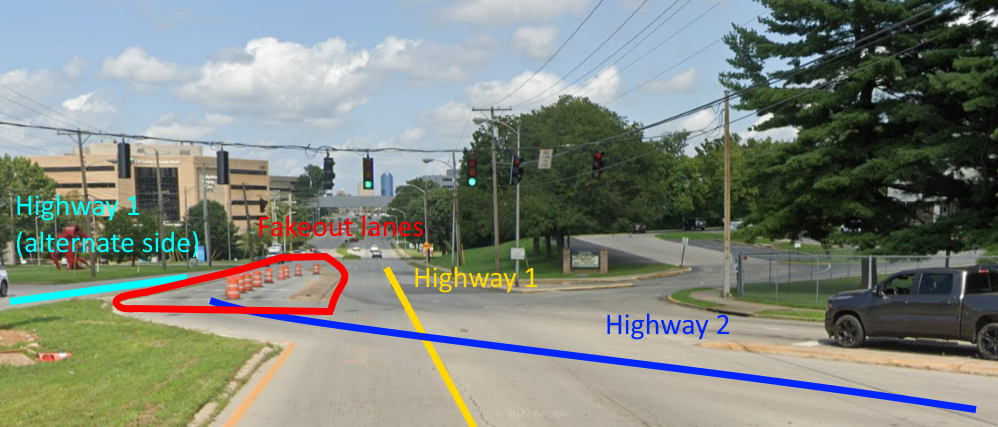Driving safely in an unfamiliar area: Thoughts, 1
How do you drive safely in an unfamiliar area? I've been thinking of attending a conference which would mean driving in just such an area, so this seemed relevant. I don't drive in distant or large cities often (understatement), so I rarely need to do this. But it seems important to get right when I have to do this, because failing to navigate properly can really screw up your day/life.
So what can you do to prepare yourself for such situations? I see a few options. Suppose that, as in this situation, you know at least a general area in which you might be driving. You can:
- Familiarize yourself with the area as much as possible ahead of time.
- Analyze situations that confused you recently.
- Give yourself space to make wrong turns.
- Get better at recovering from mistakes.
The first tactic is to get familiar. If you can drive there ahead of when you need to be there, that would be ideal, although rarely possible. If you know someone that lives in the area, especially if they recently moved there, you could ask them. Short of that you could consult maps of the area: An abstract road map, or even better, the Street View in Google Maps. The ideal is to be able to notice any traffic areas that might be confusing and figure out how to navigate them ahead of time. If you don't know specifics yet, focus on the biggest-looking roads and highways on the map within some specific-enough geographic area (e.g. "within Blah County"; "within 15 minutes of my hotel").
The second tactic is to analyze past confusions. If you can remember a specific situation in the past where you were confused, go back and analyze that. Figure out what signs (if any) could help you better navigate similar situations in the future. The hope is to reduce the number of general situations that confuse you by figuring out what things you need to pay attention to.
At the end of this post I included a detailed, illustrated analysis of a situation that confused me recently and what signs might help me navigate such situations better in the future. I think you do want to go into approximately this much detail to get the most out of this tactic, although a complete publicly-comprehensible writeup is probably not necessary. I think the example shows the idea of this tactic better than an abstract discussion would.
The third tactic is to give yourself space to make wrong turns. That means leaving with enough time that you can miss your turn without being late to whatever event or appointment you're traveling to. It also means actually inhabiting the mindset that it's not a disaster if I don't get there in the most efficient way possible. You should be okay if you miss your turn. Making a wrong turn has to feel workable. I mention this third tactic especially because I know I've fallen into the trap before of not leaving myself enough time and feeling like I had to rush to avoid disaster. At a guess, 15 minutes should be enough in my context, assuming you're not traveling during rush hour traffic. It's in fact probably a bit overkill for most trips in that context.
The fourth tactic is to get better at recovering from mistakes. That is, figure out what you will do to prevent disaster if you make a mistake and end up in a bad spot that might cause an accident. The more situations where you have a "disaster preparedness plan" of some kind – some workable response to the mistake – the better. I'll give an example of recovering from mistakes.
Say you end up on the wrong side of a median-divided highway by mistake. What do you do to "get back on track"? In this case, you could go over the median, and that might be your best option. It may not be the best for your car, but may save your life. If you don't have a car coming at you, you should probably check for traffic in the lane on the other side before doing that.
That's not the only solution. Alternatively you could stop the car and reverse back into the appropriate lane – assuming nobody has followed you (and hopefully they haven't also gotten confused!). You'd have to mind traffic in that lane, however, which sounds difficult and stressful since you also have to worry about oncoming traffic! It might be useful to also put your hazard lights to catch the attention of any drivers headed in your direction. Overall this doesn't seem like a clearly superior alternative and I don't immediately see a better one, so I'll leave that there for now.
There is one more "tactic" to mention: Paying attention. This doesn't actually seem like a tactic to me but it seems like something I'd expect people to mention. I don't think it's helpful as advice though. Obviously it's a great idea to turn off your music or radio if you normally use that, and it's for sure a great idea to not talk on the phone if you are in the habit of doing that (please don't...). But aside from turning off obvious stereotypical distractions I don't see this as a workable tactic for this situation. There is too much you need to notice and think about while driving such that "paying attention" doesn't actually seem helpful as advice for driving in an unfamiliar area.
If you are driving reasonably, you are always paying attention – but you may be paying attention to the wrong thing. That is, maybe you're paying attention to questions like: Where am I now? Where am I going? Where do I need to turn? What do I do next after that? Are there pedestrians or biciclysts? Where are they going? You may be paying close attention, but the problem is that in the moments before the potential mistake, the relevant thing to pay attention to is not "where do I need to turn?" but: Is this actually a place I can turn or is that area meant for people on the other side of the divided highway? And I don't know of useful generalizable advice for figuring out which driving-relevant things you should be paying attention to. Concrete advice seems more workable, but more covered by "analyzing situations that confused me."
Between all these factors, for the moment I'm going to ignore advice to "pay attention" as not useful to me.
Those are all the tactics I wanted to discuss today. Probably there are other tactics you can use to cope with driving in unfamiliar areas. If you have one I haven't listed here, and you can figure out how to contact me, please let me know. I'd be happy to get more ideas in this space.
Example: Analyzing a recent traffic confusion
As an example, I'll analyze a situation where I was confused recently.

Figure 1 shows an up-close view of a confusing traffic situation I ran into recently. (Street view.) This shot looks straight down a four-lane divided highway – call it highway 1. A separate four-lane road (highway 2) merges onto highway 1 from the right side here – though you can't see it in the image because of the black truck obscuring it. Highway 2 follows the left-to-right dashed lines coming from the spot with the traffic cones. (There is also a completely separate right turn into an elementary school parking lot here.) The two highways merging means there is this really weird awkward cutover where drivers on the other side of highway 1 can turn left to get onto highway 2.
I misread this situation and thought the traffic cones area was a section of left turn lanes for highway 1 to turn onto a side road. I interpreted highway 2 as actually being a one-way road merging onto highway 1. I thought the cones in those two lanes were there for some reason to divide the two left turn lanes. Of course those cones are instead for the alternate side of highway 1 to get onto highway 2. There were no cars going that way so it wasn't obvious this was wrong. Fortunately, things worked out okay – no one was hurt.

Now I want to analyze this situation. I've illustrated the complete situation in Figure 2. To make discussion easier, let's call those two distractor lanes "the fakeout lanes."
What signs might I notice in the future to avoid misunderstanding situations like this? The first signs are the left-turn symbols painted in the fakeout lanes–however these are hard to recognize as pointing the wrong way until you're nearly on top of them. Also signs: The two traffic lights that are pointing "toward" the fakeout lanes. Another sign is the median on the right which would seem odd if highway 2 were actually a one-way road merging onto highway 1. But then there are two clearer signs: The left median curve and the interrupted center line.
The next sign is the sharp way the left median curves around the fakeout lanes. If the fakeout lanes were truly left turn lanes for highway 1, I would expect the median to be more rounded and gently curve outward. If you look at the interactive street view, you can see how the median bends in such a gradual way for the actual left turn immediately after this merge intersection. Meanwhile, there is this sharp corner around the fakeout lanes which would be unusual for true left turn lanes.
There is also the interrupted center line here (see figure 1). The center line for this side of highway 1 breaks and is interrupted by highway 2's line, which merges into the line from the alternate side turn lanes. If those two lanes on the left were left turns for highway 1, I would expect to see highway 1's dotted line continue straight with a new line splitting off for the turn lanes. Instead we have this break where highway 1's center line stops and only resumes later on, which would be weird if the fakeout lanes were actually left turn lanes for this side of highway 1.
Some of these are subtle. I doubt I would notice the turn symbols while driving in an unfamliar area. The wrong-way lights are a little more obvious, as is the median. But I think the median curve and the interrupted center line seem like the most obvious indications that this is not a left turn lane. These are all things I can look out for next time I'm driving in an unfamiliar area that might help me navigate.